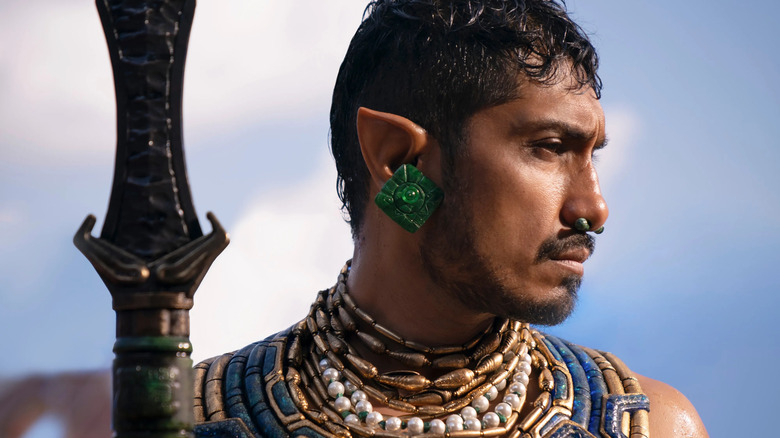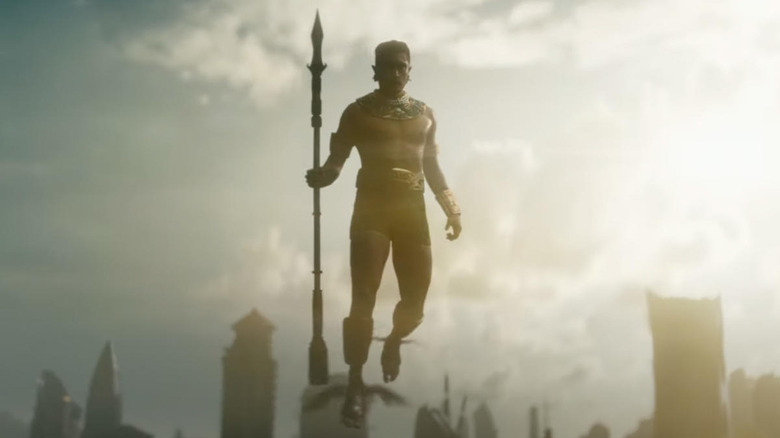Namor's Ankle Wings Presented Black Panther VFX Artists With A Challenge
In Ryan Coogler's 2022 sci-fi war epic "Black Panther: Wakanda Forever," a pair of fantastical, magical kingdoms go to war over a rare element called vibranium. Vibranium is a magical, energy-producing metal that allows both kingdoms to build amazing machines, and shield their existence from the human world. On one side, there is the titular Wakanda, an African nation that is home to the superhero Black Panther (Letitia Wright). On the other side is Talokan, a Mesoamerican realm deep beneath the Atlantic Ocean, overseen by the amphibious Namor (Tenoch Huerta). Like many films in the Marvel Cinematic Universe, the plot is unnecessarily complicated, but the visuals are first-rate, and the Afrofuturist aesthetic is amazing.
The inclusion of Namor was something of a coup for the MCU, as Namor the Sub-Mariner was famously one of the very first Marvel superheroes, having appeared in Marvel Comics #1 back in 1939. Namor was created by Bill Everett. In both the comics and in "Wakanda Forever," Namor sported a bare chest, pointed ears, and, in a mythological flourish, a pair of miniature wings on each foot. The wings were clearly inspired by common depictions of the god Mercury, and Namor's miniature wings flapped furiously to keep him aloft during high-octane superhero fights.
The Marvel Cinematic Universe is, of course, populated by all manner of aliens, gods, wizards, witches, animal-hybrid people, and at least one professional archer, so the sight of a man with little wings on his ankles should have fazed anyone. Regardless, the VFX technicians working on "Wakanda" were concerned that Namor might look a little silly. In a 2022 interview with SyFy, VFX supervisor Hanzhi Tang explained what everyone did to make Namor look real and dynamic.
Namor's cute little Mercurian wings
Thanks to Superman, the public at large sees flying superheroes as merely lifting off the ground with only a thought. Superman then flies head-first through the air, his arms often outstretched in front of him. This, of course, is to make his body more aerodynamic. Superman, we all seem to intuit, is being lifted from within by his chest, or perhaps with his whole torso. Namor, in contrast, doesn't lift his own body via telekinesis or some eerie antigravity measure but is propelled forward from his foot wings. This meant animating a digital version of Tenoch Huerta in new, unusual poses not usually seen in superhero cinema. Hanzhi Tang explained his ethos with Namor, saying that he looked to athletes for reference. He said:
"Any caped superheroes who's flying around, you center that movement, leading with the chest, but here, everything is based around his ankles and his feet. [...] So he has more athletic movements and I think a lot of reference was either ice hockey or football in the way that he changes direction. It comes from the waist, the way he pushes himself against the air and steps through the air."
If Namor wants to slow down while speeding through the skies, he must swivel his feet forward and "flap" in the opposite direction. One can see the body movement as being similar to an ice hockey player who skitters to a halt by grinding their skates sideways.
The effect was uncanny, and /Film even felt that Namor was one of the coolest villains in the long-running Marvel film series. Namor may return, although it will be contingent on the unclear future of the MCU; we're going to be getting fewer movies moving forward, not more.

